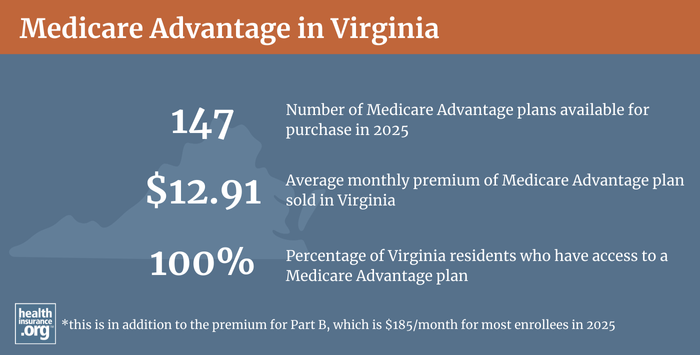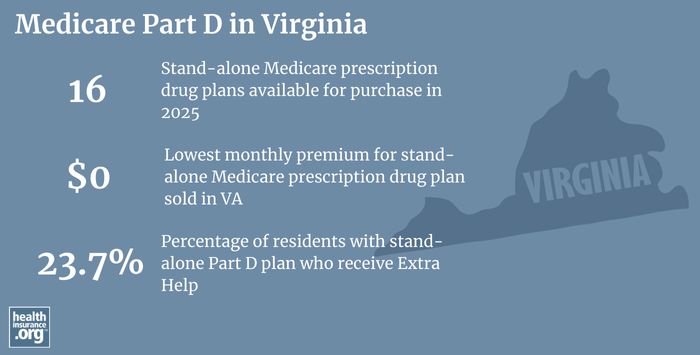Medicare in Virginia

Recently enacted legislation will limit under-65 Medigap premiums as of 2024, and extend Medigap protections to people with kidney failure
Key takeaways
- More than 1.6 million residents are enrolled in Medicare in Virginia.1
- More than one-third of Virginia Medicare beneficiaries (38%) are enrolled in Medicare Advantage plans.1
- More than 1.2 million Virginia Medicare beneficiaries have Medicare Part D prescription drug coverage, either under stand-alone plans or as part of their Medicare Advantage coverage.1
- There are 16 stand-alone Medicare Part D prescription drug plans available in Virginia for 2025, with premiums starting at $0 per month.2

Virginia Medicare enrollment
1,687,566 residents were covered by Medicare in Virginia as of September 2024.1 Most Americans become eligible for Medicare enrollment when they turn 65. But nationwide, there are over 7 million people under the age of 65 who have Medicare coverage.3 This is because Medicare eligibility is also triggered once a person has been receiving disability benefits for 24 months, or has kidney failure or amyotrophic lateral sclerosis (ALS). As of September 2024, more than 175,000 Medicare beneficiaries in Virginia were under the age of 65,1 accounting for more than 11% of the state’s Medicare population.
The annual Medicare coverage enrollment window (Medicare Annual Election Period) runs from October 15 to December 7 each year, and allows Medicare beneficiaries the chance to switch between Medicare Advantage plan enrollment and Original Medicare, and the option to add, drop, or switch to a different Medicare Part D prescription drug plan. People who are already enrolled in Medicare Advantage also have the option to switch to a different Medicare Advantage plan or to Original Medicare during the Medicare Advantage open enrollment period, which runs from January 1 to March 31.
- Read our guide to Medicare’s open enrollment.
- Understand the difference between Medigap, Medicare Advantage, and Medicare Part D.
- Learn about how Virginia’s Medicaid program can provide financial assistance to Medicare beneficiaries with limited financial means (income and assets).
Learn about Medicare plan options in Virginia by contacting a licensed agent.



Explore our other comprehensive guides to coverage in Virginia

We’ve created this guide to help you understand the Virginia health insurance options available to you and your family, and to help you select the coverage that will best fit your needs and budget.


Hoping to improve your smile? Dental insurance may be a smart addition to your health coverage. Our guide explores dental coverage options in Virginia.


Learn about Virginia’s Medicaid expansion, the state’s Medicaid enrollment and Medicaid eligibility.


Short-term health plans provide temporary health insurance for consumers who may find themselves without comprehensive coverage. Learn more about short-term plan availability in Virginia.

Frequently asked questions about Medicare in Virginia
What is Medicare Advantage?
Medicare beneficiaries can choose to get their healthcare coverage through Medicare Advantage plans, or directly from the federal government via Original Medicare (which includes hospital coverage via Medicare Part A and outpatient/medical coverage via Medicare Part B).
Medicare Advantage plans include the same covered benefits of Medicare Part A and Part B, and most plans include Part D prescription drug coverage as well as additional benefits such as gym memberships, nurse hotlines, and dental and vision coverage, as well as various other supplemental benefits.
But provider networks may be smaller with Medicare Advantage plans, and although monthly plan premiums may tend to be lower than they’d be with Original Medicare plus Medicare Part D prescription drug plan plus a Medigap plan, out-of-pocket costs may tend to be higher if the person has just a Medicare Advantage plan. There are pros and cons to either option, and the right solution depends on each enrollee’s circumstances and preferences.
Medicare Advantage plans are offered by private insurers, so plan availability varies from one area to another. There are 147 Medicare Advantage plans offered in Virginia for 2025,2 but plan availability varies by county.4
As of 2018, less than 20% of Virginia Medicare beneficiaries were enrolled in Medicare Advantage plans; nationwide, the average was more than 35% at that point. As of September 2024, total Medicare Advantage plan enrollment in Virginia stood at 648,595 people, amounting to about 38% of the state’s Medicare population.1
Most of those enrollees had Medicare Advantage plans, but there are also some people in Virginia who have Medicare Cost plans, which are a type of Medicare coverage. The rest of Virginia’s Medicare beneficiaries, amounting to more than one million people, had Original Medicare as of late-2024.1
Nationwide, enrollment in Medicare Advantage plans has been steadily growing, and had reached about 50% of all beneficiaries as of 2024.3

What is Medigap?
Original Medicare does not limit out-of-pocket healthcare costs (coinsurance and deductibles), so most enrollees maintain some form of supplemental coverage. Nationwide, more than 80% of Original Medicare beneficiaries have some type of supplemental coverage.
The supplemental coverage can be from an employer-sponsored plan or Medicaid. But for those who don’t have access to either of these, Medigap plans (also known as Medicare supplement insurance plans, or MedSupp) will pay some or all of the out-of-pocket costs they would otherwise have to pay if they only had Original Medicare.
437,832 Medicare beneficiaries in Virginia had Medigap coverage as of 2022, according to an America’s Health Insurance Plans (AHIP) analysis.5
Medigap plans are sold by private insurers, but they’re standardized under federal rules and regulated by state laws and insurance commissioners.6 36 insurers offer Medigap plans in Virginia as of 2025.7 The state debuted a Medigap premium comparison tool in 2022.8
Virginia allows Medigap insurers to pick their own rating approach, so all of the plans for sale in the state use attained-age rating.9 This means that an enrollee’s premiums will increase as they get older, regardless of how old they were when they first enrolled (the other two approaches to Medigap premiums are issue-age rating, in which premiums are based on the age the person was when they enrolled, and community rating, which means premiums don’t vary base on age; some states require one of these approaches,10 but Virginia does not).
Federal rules require Medigap insurers to offer plans on a guaranteed-issue basis during an enrollee’s Medigap Open Enrollment Period, which begins when the person is at least 65 years old and enrolled in Medicare Part B (and Part A; you have to be enrolled in both to obtain Medigap). But federal rules do not guarantee access to Medigap plans for people under age 65.
In Virginia, less than 12% of Medicare beneficiaries (over 175,000 people) were under age 65 as of September 2024.1 The majority of the states have enacted rules to ensure access to Medigap plans for disabled enrollees under age 65; Virginia joined them with legislation that was signed into law in 2020 and took effect in 2021.
Medigap insurers in the state must offer at least one plan on a guaranteed-issue basis to Virginia residents who become eligible for Medicare prior to the age of 65 due to a qualifying disability. As of January 1, 2024, the definition of a qualifying disability has been expanded to include under 65 end-state renal disease (ESRD) patients, create a new open enrollment period, and places a limitation on premium rates that issuers may charge Medigap plans.11
It’s noteworthy that there are a dozen states that require Medigap insurers to sell plans to beneficiaries under age 65, and also limit the premiums that can be charged for the coverage.
Disabled Medicare beneficiaries have access to the Medigap Open Enrollment Period when they turn 65. At that point, they have access to any of the available Medigap plans in their state, at the standard age-65 rates.
Another crucial point about HB1640/SB1409 is that the bills will extend Medigap eligibility to Virginia residents who are under 65 and eligible for Medicare due to end-stage renal disease (ESRD; kidney failure), and it will allow existing ESRD beneficiaries a one-time six-month enrollment window, starting January 1, 2024, when they can sign up for Medigap coverage. Prior to 2024, Virginia Medigap eligibility under SB250 is based on disability as defined in U.S. Code § 426(b), which does not include people with kidney failure — their eligibility is defined in 42 U.S. Code § 426–1 instead. But HB1640/SB1409 will ensure Medigap eligibility also extends to those with ESRD.
There are a few other states that require Medigap plans to be available to people under age 65 but specifically exclude people with end-stage renal disease. Notably, however, this is a population that is very much in need of Medigap coverage, as their 20% share of the cost of dialysis under Medicare Part B can become unaffordable very quickly. Since 2021, however, people with kidney failure have been able to join Medicare Advantage plans, which do have caps on in-network out-of-pocket healthcare costs; prior to 2021, these beneficiaries could not join Medicare Advantage plans unless there was a special needs plan available in their area that matched their medical conditions.
Similar bills to ensure Medigap access for disabled beneficiaries ( SB1351 in 2017 and SB161 in 2018) were introduced in Virginia in prior years but didn’t advance out of committee, but the legislation eventually succeeded in 2020.
In 2017, Virginia’s Joint Commission on Health Care conducted a study, led by Senior Health Policy Analyst, Stephen Weiss, to gather data and provide lawmakers with information related to the possibility of requiring Medigap insurers in the state to offer coverage to beneficiaries under age 65.
The JCHC study included surveying the state’s Medigap insurers; none of them indicated that they would exit the market if required to offer coverage to disabled beneficiaries under age 65, but more than half noted that if the state were to mandate coverage offerings for people under 65, the insurers would prefer that it be only Plan A, instead of all plan options (several states have taken this approach). And they also indicated that premiums would need to be between one and a half and five times higher for enrollees under the age of 65. Ultimately, however, JCHC voted to take no action on this issue at that point, and it wasn’t until 2020 that legislation was enacted to address it.
Once the law was enacted and implemented, it very much reflected what the insurers asked for: Only one plan has to be offered, and the premiums can be dramatically higher for the under-65 population.
What is Medicare Part D?
Original Medicare does not provide coverage for outpatient prescription drugs. Nationwide, more than 80% of Original Medicare beneficiaries supplemental coverage,12 and if these plans are offered by a current or former employer, they often include prescription benefits.
But Medicare Part D, created under the Medicare Modernization Act of 2003, provides prescription drug coverage for Medicare beneficiaries who do not have another source of coverage for prescription costs (this includes beneficiaries who are dually-eligible for both Medicare and Medicaid; their prescription coverage is provided via Part D).
Medicare beneficiaries can enroll in Medicare Part D prescription drug plans on a stand-alone basis, or obtain Medicare Part D prescription drug coverage integrated with a Medicare Advantage plan (not all Medicare Advantage plans include Medicare Part D prescription drug benefits, but most do). Both options are available for purchase (or plan changes) during the Medicare Annual Election Period that runs from October 15 to December 7 each year, with the new coverage effective January 1 of the coming year.
There are 16 stand-alone Medicare Part D prescription drug plans in Virginia for 2025, with premiums that start at $0 per month.2
As of September 2024, there were 655,337 Virginia beneficiaries with stand-alone Medicare Part D prescription drug coverage, and another 587,925 with Medicare Advantage plans that included integrated Medicare Part D prescription drug coverage.1
Medicare Part D prescription drug plan enrollment is available when a person is first eligible for Medicare, and during the Medicare Annual Enrollment Period each fall, from October 15 to December 7. Plan selections and changes made during this window take effect on January 1.

How does Medicaid provide financial assistance to Medicare beneficiaries in Virginia?
Many Medicare beneficiaries receive financial assistance through Medicaid with the cost of Medicare premiums and services Medicare doesn’t cover – such as long-term care.
Our guide to financial assistance for Medicare enrollees in Virginia includes overviews of these benefits, including Medicare Savings Programs, long-term care coverage, and eligibility guidelines for assistance.
What additional resources are available for Medicare beneficiaries and their caregivers in Virginia?
You can contact VICAP (Virginia Insurance Counseling and Assistance Program), with questions related to Medicare eligibility, enrollment, and coverage in Virginia.
The Virginia State Corporation Commission/Bureau of Insurance website offers a variety of information and resources about Medicare Advantage, Medicare Part D, and Medigap plans that are sold in Virginia. They can provide customer service, answer questions, and address complaints about entities they regulate, including health insurance companies and the brokers/agents who sell policies in the state.
This guide to Medicaid assistance for Medicare beneficiaries in Virginia is a useful resource that explains the various programs available to people with low income and asset levels, and how to apply for assistance.
Medicare Rights Center is a nationwide service, with a website and call center, where Medicare beneficiaries can get answers to their questions and assistance with understanding the eligibility and enrollment process for Medicare.
Louise Norris is an individual health insurance broker who has been writing about health insurance and health reform since 2006. She has written dozens of opinions and educational pieces about the Affordable Care Act for healthinsurance.org.
Footnotes
- “Medicare Monthly Enrollment – Virginia.” Centers for Medicare & Medicaid Services Data. Accessed January, 2025. ⤶ ⤶ ⤶ ⤶ ⤶ ⤶ ⤶ ⤶ ⤶
- ”Fact Sheet: Medicare Open Enrollment for 2025” (140) Centers for Medicare & Medicaid Services. Sep. 27, 2024 ⤶ ⤶ ⤶
- “Medicare Monthly Enrollment – US” Centers for Medicare & Medicaid Services Data. Accessed, January 2025. ⤶ ⤶
- ”Medicare Advantage 2025 Spotlight: First Look” KFF.org Nov. 15, 2024 ⤶
- ”The State of Medicare Supplement Coverage” AHIP. May 2024 ⤶
- “Medigap (Medicare Supplement Health Insurance).” CMS.gov. Accessed December, 2024. ⤶
- “Supplement Insurance (Medigap) Plans in Virginia.” Medicare.gov. and “Virginia Medigap Plan Search” Virginia SCC. Accessed Jan. 14, 2025 ⤶
- “SCC Bureau of Insurance Offers New Medigap Premium Comparison Tool.” Virginia SCC – New Releases, September 1, 2022. ⤶
- ”Understanding Medicare Supplement Insurance (Medigap)” Division of Aging and Adult Services,
City of Alexandria, VA. Accessed Jan. 14, 2025 ⤶ - ”Key Facts About Medigap Enrollment and Premiums for Medicare Beneficiaries” KFF.org. Oct. 18, 2024 ⤶
- “Medicare Supplement Policies for Certain Individuals Under Age 65: FAQ.” scc.virginia.gov, August 2023. ⤶
- Ochieng, Nancy, and Jeannie Fuglesten Biniek. “Cost-Related Problems Are Less Common among Beneficiaries in Traditional Medicare than in Medicare Advantage, Mainly Due to Supplemental Coverage.” Kaiser Family Foundation, July 7, 2021. ⤶

